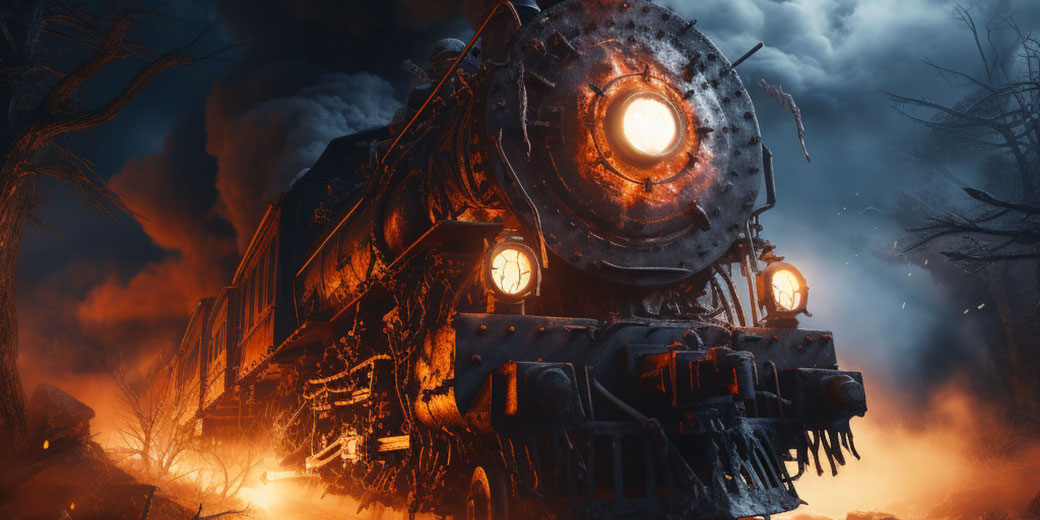Trains, terror, and technological change: 19th century hysteria about railways

In the early 19th century, the advent of steam-powered trains, or the "iron horses" as they were then known, marked a significant milestone in the era of the industrial revolution.
With their enormous power and speed, these locomotives not only revolutionized transport and communication, but also induced a profound sense of fear and anxiety among the populace.
As with any major technological advancement, steam trains brought with them a mix of excitement, opportunity, trepidation, and dread.
The locomotive as a symbol of change
Steam locomotives emerged at a time of rapid social and economic transformation.
Industrialization was rapidly reshaping the landscape, both figuratively and literally.
The steam train, with its loud noise, billowing smoke, and tremendous speed, served as a tangible and visceral symbol of these changes.
The sight and sound of a steam locomotive racing across the countryside represented the shock of the new and the unfamiliar.
Fear of speed
One of the most prominent fears was related to the sheer speed of steam locomotives.
Before the steam train, horse-drawn carriages and canal boats were the primary modes of long-distance transport, reaching speeds of merely 4 to 6 miles per hour.
The first steam trains, on the other hand, could reach speeds of up to 30 miles per hour — a mind-boggling velocity for the era.
Many people feared that the human body could not withstand such speed. There were widespread beliefs that passengers would suffocate if exposed to such speeds or even that the swift motion could cause organ displacement.
Lethal machines from hell
The safety concerns surrounding steam trains were not entirely unfounded.
Railway accidents, while not common, did occur, and when they did, the results were often catastrophic.
Boiler explosions, derailments, and collisions were real risks that fed into the public's fears.
This concern was particularly heightened by news reports of accidents like the Versailles rail accident in France in 1842, where over 50 people were killed when a train derailed and caught fire.
Moreover, the monstrous visage of these roaring, hissing machines, belching smoke and sparks, could indeed appear terrifying, especially to those unaccustomed to such a spectacle.
Social disruptions
The anxieties surrounding steam trains were not merely about their physical attributes or safety.
They also represented a significant disruption to societal norms. Railways broke down geographical barriers, allowing people and goods to move rapidly across long distances.
This facilitated urbanization, contributed to the growth of capitalism, and upset traditional rural lifestyles.
Many people were apprehensive about the societal changes that this technological advancement was bringing about.
The construction of railways also often required the seizure of land, resulting in disputes and causing resentment.
This was especially the case in the United Kingdom where the passage of railway acts in Parliament, permitting the compulsory purchase of land for railways, often sparked controversy.
Damage to plants and animals
One such fear was that the smoke emitted from steam engines could "blight" crops and poison the air, leading to widespread environmental and health catastrophe.
This concern was part of a broader anxiety about the industrial pollution associated with the era.
Interestingly, there were also fears tied to more superstitious beliefs. For instance, there was a concern that the speed and noise of the steam locomotives would scare away livestock or cause cows to stop producing milk.
This was part of a broader fear that the railway might disrupt the balance of rural life, threatening the livelihood of those dependent on farming.
Trains would increase crime and other immoral acts
Perhaps the most irrational fear was that the steam train could lead to moral degradation.
The rapid movement of people was feared to encourage criminal activities by making it easier for criminals to flee from the scene of their crimes.
Additionally, there were fears about the mixing of classes and sexes in the confined spaces of railway carriages.
Some worried that this could lead to a breakdown of social hierarchies and moral standards, as people from different walks of life interacted in ways they previously hadn't.
Moreover, many saw the steam train as a symbol of man's hubris, defying the natural order of things.
This was a time when society was deeply religious, and the notion that man could create a machine that could move faster and carry more than any horse was seen by some as challenging the laws of nature and God.
Are we much different in our own fears?
The advent of the steam train in the 19th century prompted a mix of fear and excitement.
While we may look back now and marvel at the quaintness of their fears, it's crucial to remember that these concerns were rooted in the genuine uncertainty of an era experiencing rapid and profound change.
It is a cycle that has repeated with every major technological advance, from the automobile to the internet, and continues even to this day.
Each new leap forward brings its own set of apprehensions, as society grapples with the implications and consequences of the new and unfamiliar.
What do you need help with?
Download ready-to-use digital learning resources
Copyright © History Skills 2014-2025.
Contact via email
With the exception of links to external sites, some historical sources and extracts from specific publications, all content on this website is copyrighted by History Skills. This content may not be copied, republished or redistributed without written permission from the website creator. Please use the Contact page to obtain relevant permission.





